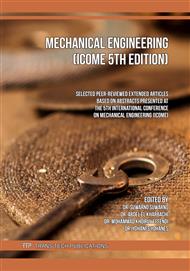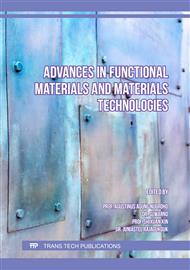[1]
Keshavamurthy R, Naveena B.E, and N.S Sekhar: Thermal Spray Coatings for Erosion-Corrosion Protection. In book: Production, Properties, and Applications of High Temperature Coatings, university of Tehran, Iran & Materials and Energy Research Center, Iran, pp.246-267 (2018).
DOI: 10.4018/978-1-5225-4194-3.ch010
Google Scholar
[2]
S. Ramandhany, et al.: The reactive element effect of yttrium and yttrium silicon on high-temperature oxidation of NiCrAl coating, IOP Journal of. Physics: Conf. Ser. 985 012039, (2018).
DOI: 10.1088/1742-6596/985/1/012039
Google Scholar
[3]
A.S.M Ang, C.C Berndt: A review of testing methods for thermal spray coatings. Int. Mater. Rev. 2014, 59, p.179–223.
Google Scholar
[4]
A. Nouri, A. Sola: Powder Morphology in Thermal Spray: a review, Journal of Advanced Manufacturing and Processing (Wiley, 2019).
Google Scholar
[5]
K. Murugan, A. Ragupathy, V. Balasubramanian, K. Sridhar: Optimizing HVOF spray process parameters to attain minimum porosity and maximum hardness in WC-10Co-4Cr coatings, Surface and Coatings Technology, 247:90-102, (2014).
DOI: 10.1016/j.surfcoat.2014.03.022
Google Scholar
[6]
M. Oksa, et.al.: Optimization and Characterization of High Velocity Oxy-Fuel Sprayed Coatings: Techniques, materials, and Applications, Coatings, Vol.1, Issues 1. (2011).
DOI: 10.3390/coatings1010017
Google Scholar
[7]
E.Martides, et.al: The Influence of Particles Size and Composition Variation of NiCr-CrC(20NiCr) Metal Matrix Composites Coatings Properties on Boiler Tubes Application, Materials Science Forum,Vol. 889, pp.30-35, (2016).
DOI: 10.4028/www.scientific.net/msf.889.30
Google Scholar
[8]
R. Kumar and S. Kumar: Thermal Spray Coating: A Study, International Journal of Engineering Sciences & Research Technology, 7(3), pp.610-617, (2018).
Google Scholar
[9]
P. Selvam, et.al: Erosion-Corrosion Protection Due to Cr3C2-NiCr Cermet Coating on Stainless Steel, Coatings, 10, 1042, (2020).
DOI: 10.3390/coatings10111042
Google Scholar
[10]
Henry Semat, Robert Katz: Physics, Chapter 9: Hydrodynamics (Fluid in Motion) (Robert Katz Publications, University of Nebraska, Lincoln).
Google Scholar
[11]
ASTM D2794-93, Standard Test Method for Resistance of Organic Coatings to the Effects of Rapid Deformation (Impact) (ASTM International, 2019).
Google Scholar
[12]
C.W. Kanyiri, et.al: Analysis of Flow Parameters of a Newtonian Fluid through a cylindrical Collapsible Tube, Springerplus, 3:566, (2014).
DOI: 10.1186/2193-1801-3-566
Google Scholar
[13]
A. Purniawan, H. Irawan, and S.T. Wicaksono : Microstructure and Adhesion Properties Post-Annealed Metallic Coating of FeCrBMnSi on Tube and Internal Structure Coal-Fired Boiler, The 2nd International Conference on Civil Engineering Research- ICCER (2016).
DOI: 10.12962/j23546026.y2017i1.2200
Google Scholar
[14]
G. Straffelini, and M. Federici: HVOF Cermet Coatings to Improve Sliding Wear Resistance in Engineering Systems, Coatings, 10(9), 886, (2020).
DOI: 10.3390/coatings10090886
Google Scholar



